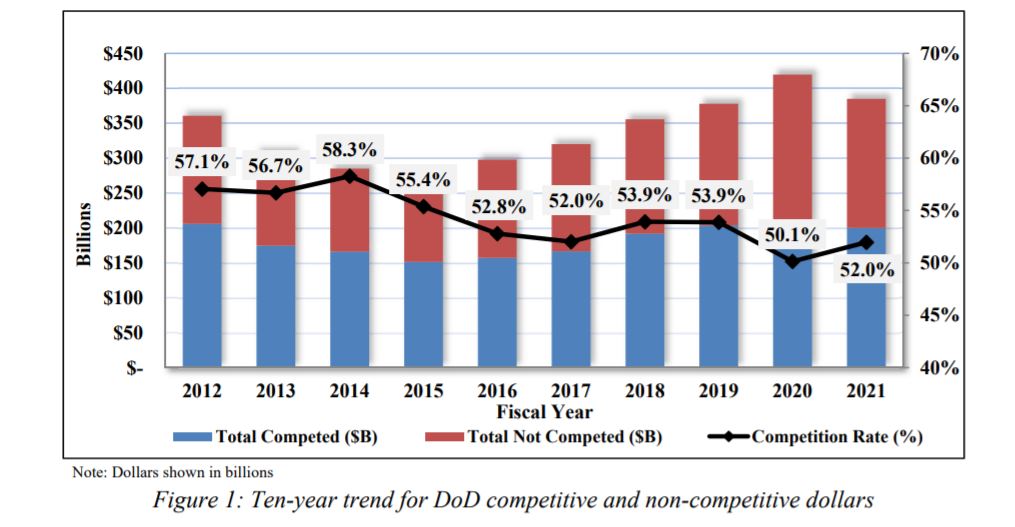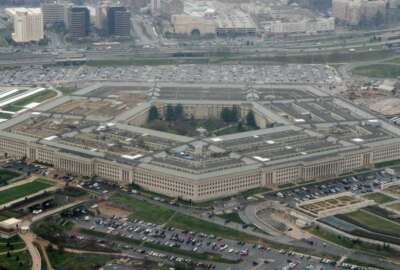Defense contractor revenue is strong, so why is the state of the sector weakening?
New reports from DoD and NDIA highlight ongoing challenges the defense industrial base is facing in light of rising tensions among near peer competitors.
Best listening experience is on Chrome, Firefox or Safari. Subscribe to Federal Drive’s daily audio interviews on Apple Podcasts or PodcastOne.
The Defense Department’s mandated report from President Joe Biden’s July executive order on promoting competition would lead you to think the shrinking supply chain is putting the nation at risk.
“Since the 1990s, the defense sector has consolidated substantially, transitioning from 51 to 5 aerospace and defense prime contractors,” the Feb. 15 report stated. “As a result, DoD is increasingly reliant on a small number of contractors for critical defense capabilities. Consolidations that reduce required capability and capacity and the depth of competition would have serious consequences for national security.”
A week before that report dropped, the National Defense Industrial Association (NDIA) rang the alarm bells that played a similar tune.
NDIA’s 2022 Vital Signs report found the health of the DIB at its lowest point since the launch of the review with five of eight categories falling below the passing grade of 70 out of 100.
“Vital Signs 2022 also reflects the story of recent political and regulatory action against adversaries and their influence over the DIB, and the way in which that has shaped and will continue to shape the future of the warfighter,” the NDIA and Govini found in the report. “This past year has witnessed significant deterioration in the signs including ‘supply chain’ as well as ‘production capacity and surge readiness,’ which almost certainly is a result of the impact of the pandemic. Conversely, the only sign that significantly improved was ‘demand,’ reflecting recent growth in the defense budget.”
But these reports really only tell one side of the story.
Conversely, the data on overall spending, the rate of competition and the total revenue all point to an industrial base that is healthy, wealthy and, hopefully, a little wiser.
Bloomberg Government found in its fiscal 2020 report — the most recent data available — that most of the top 10 contractors across government, not just within DoD, saw their revenue increase over the previous year.
Lockheed Martin, for example, repeated as the top contractor in 2020, bringing in $75.8 billion in federal contracts, up from $43.4 billion in 2019. In 2021, NDIA reported Lockheed earned $74.9 billion, while the other top five DIB vendors, Raytheon, General Dynamics, Boeing and Northrop Grumman all saw decreases between 2021 and 2020.
It’s not just about straight revenue either. DoD reports that the overall competition rate among contractors reached 52% in 2021, more than 1% higher than 2020, but lower or equal to the rate each year since 2012.
The increased competition rate along with the revenue increases comes despite growing concerns about mergers and acquisitions negatively impacting the price for specific products like major weapons systems DoD pays as well as availability of products and services.
“Although studies of this trend have not found a strong correlation between consolidation and increased program pricing, additional risks beyond pricing come with consolidation,” DoD stated. “Growing concentration can reduce the availability of key supplies and equipment, diminish vendors’ incentives for innovation and performance in government contracts, and lead to supply chain vulnerabilities.”

The DoD and NDIA report are part of a growing drum beat across the defense sector warning lawmakers about the growing near peer competition coming from Russia, China and other countries and whether the defense industrial base can keep ahead of them.
As Congress looks to complete its fiscal 2022 spending bill and begins to work on 2023, the reports highlight both real and perceived threats for lawmakers to consider as they parse out the more than $700 billion DoD budget.
“Many of these challenges were there before COVID. The pandemic served to highlight and accelerate these challenges. But it is definitely a wake-up call for the decision and policymakers in our country,” said retired Air Force Gen. Herbert “Hawk” Carlisle, the president of NDIA, during a press briefing on Feb. 2. “The aggressive Russian military buildup on the Ukrainian border and the pacing threat, the rapid military modernization efforts of the People’s Republic of China remind us that our industries work of providing superior products and services to armed services so that they can compete and win and all domains of warfare can never be taken for granted. We owe it to the women and men that serve and defend this nation to give them the equipment, the capability and the training to do the mission we asked them to do and right now in the environment we’re operating in. It’s a challenge and we got a lot of work to do.”
Chinese investment in AI
Tara Murphy Dougherty, the CEO of Govini, added the Vital Signs 2022 report should serve as a “wake-up call” for DoD, Congress and the White House to better understand just how challenging the current federal procurement environment has become over the last decade.
“The challenging environment does not impact just the companies that the Department of Defense is already working with today. The more difficult the dynamics of working with DoD are, the more the department will continue to struggle to bring new entrants into this market. We know as a national security community that the Department of Defense has to bridge the gap between the traditional members of the defense industrial base who today continue to contribute so much into the emerging national security innovation base. DoD has to attract the companies that are working on a bleeding edge technology in the commercial sector of the United States economy,” Murphy Dougherty said. “If we cannot accomplish that, the techno military challenge and competition that we’re facing with China will continue to undoubtedly get more difficult. If you consider comparative investments between the United States and the Chinese Communist Party in these emerging technologies, and the commitment that China has to leveraging those technologies for warfare, it’s clear what DoD needs to do. That begins by improving the environment in which these companies operate in order to serve DoD and the national security efforts of our country.”
It’s the concerns about the gains China and Russia are making is helping to drive this mixed message about the DIB.
Both reports found the number of new entrants coming into the defense sector has steadily dropped. DoD says the reduction is felt most among weapons suppliers, which fell to 5 from 51 in the 1990s.
Wes Hallman, the senior vice president for strategy and policy for NDIA, said the lack of new entrants into the DIB is surprising and concerning, especially during the pandemic.
“Two different studies one from 2008 to 2018, and one that was 2011 through 2018 noted thousands of companies have left the defense industrial base. We’ve noted that the number of new entrants between 2019 and 2020 went from over 12,000 to just over 6,000. We saw another drop from 6,500 down to 6,300 new entrants over the last fiscal year [2020 to 2021],” Hallman said. “When you look at the supply chain issues and the many, many years of a dwindling supply base create more and more fragile networks. Then the pandemic really highlighted the fragility of that. As policymakers look at this, we need to look at what are the incentives and disincentives to come in into this marketplace and really adjust the marketplace so it’s so it’s easier to enter it easier to thrive in it and then produce some resilience.”
More vendors in R&D defense sector
Carlisle added that the drop in new entrants comes despite the defense sector being somewhat protected against the economic challenges brought on by the pandemic.
The one area that has bucked this shrinking trend is research and development where the use of other transaction authority has increased the number of vendors by 9% over the last decade, DoD reported.
Dr. Mark Lewis, the executive director of NDIA’s Emerging Technologies Institute (NDIA ETI), said DoD must reverse the spending decline on basic research as a way to address many of these growing DIB problems.
“We won’t have those the next set of emerging technologies if we’re not investing in the basic research that will, we’ll get there. I think we can certainly highlight some successes of the Defense Innovation Unit, which has been incredibly successful at kind of opening the door for new companies to come into the DoD,” Lewis said. “Very recently, Under Secretary of Defense, Heidi Shyu announced instead of reducing the number of modernization priorities, she’s actually into adding a few modernization priorities, which I think is wholly appropriate. So there’s still, obviously a very keen focus on these emerging technologies, and I think there’s a sense of alacrity, but again, we’re getting some mixed messages along those lines. So it remains to be seen. And I think we’ll certainly see when the 2022 National Defense Strategy is released if it continues to emphasize the importance of these emerging technologies, and especially with a focus on peer competitors, such as Russia and China.”
It’s clear there is no one solution to reinvigorating the defense industrial base. It’s clear the continuing resolutions, the long acquisition cycles and the complexity of the procurement process all play into the challenges. At the same time, DoD and its contractors haven’t done enough to help themselves as spending keeps increasing and companies keep winning more contracts.
Copyright © 2025 Federal News Network. All rights reserved. This website is not intended for users located within the European Economic Area.
Jason Miller is executive editor of Federal News Network and directs news coverage on the people, policy and programs of the federal government.
Follow @jmillerWFED






